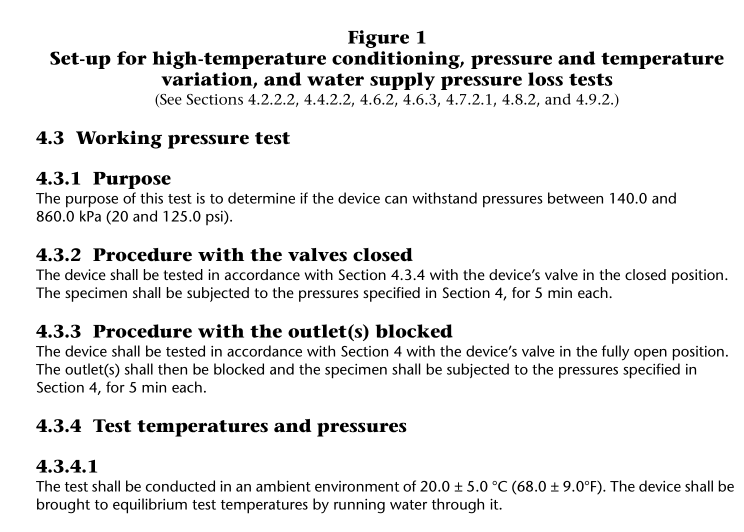ASME A112.1016:2011 pdf free download Set-up for high-temperature conditioning, pressure and temperature variation, and water supply pressure loss tests
4.3 Working pressure test
4.3.1 Purpose
The purpose of this test is to determine if the device can withstand pressures between 1 40.0 and 860.0 kPa (20 and 1 25.0 psi).
4.3.2 Procedure with the valves closed
The device shall be tested in accordance with Section 4.3.4 with the device’s valve in the closed position.
The specimen shall be subjected to the pressures specified in Section 4, for 5 min each.
4.3.3 Procedure with the outlet(s) blocked
The device shall be tested in accordance with Section 4 with the device’s valve in the fully open position.
The outlet(s) shall then be blocked and the specimen shall be subjected to the pressures specified in Section 4, for 5 min each.
4.3.4 Test temperatures and pressures
4.3.4.1
The test shall be conducted in an ambient environment of 20.0 ± 5.0 °C (68.0 ± 9.0°F). The device shall be brought to equilibrium test temperatures by running water through it.
4.3.4.2
Test temperatures and pressures shall be as follows:
(a) 1 40.0 ± 1 3.8 kPa and 1 0.0 ± 6.0 °C (20.0 ± 2.0 psi and 50.0 ± 1 0.0°F);
(b) 860.0 ± 1 3.8 kPa and 1 0.0 ± 6.0 °C (1 25.0 ± 2.0 psi and 50.0 ± 1 0.0°F);
c) 1 40.0 ± 1 3.8 kPa and 66.0 ± 6.0 °C (20.0 ± 2.0 psi and 1 50.0 ± 1 0.0°F); and
(d) 860.0 ± 1 3.8 kPa and 66.0 ± 6.0 °C (1 25.0 ± 2 psi and 1 50.0 ± 1 0.0°F).
4.3.5 Failure criteria
Leakage or other failures of the seals shall result in the rejection of the device.
4.4 Maximum operating torque or force adjustment test
4.4.1 Purpose
The purpose of this test is to determine the maximum torque or force required to adjust the device.
4.4.2 Procedure
4.4.2.1
Conduct the tests specified in Clause 5.5 of ASME A1 1 2.1 8.1 /CSA B1 25.1 .
4.4.2.2
After the tests specified in Section 4.4.2.1 , the following tests shall be conducted:
(a) Set up the specimen as specified in Items (a) to (f) of Section 4.6.3. See Figure 1 .
(b) Move the adjusting mechanism of the specimen (e.g., handle(s) or lever(s)) through its full operating range. The force shall be applied at the extreme end of the adjusting mechanism.
(c) Record the maximum operating torque or force.
4.4.3 Failure criteria
A maximum operating torque or force to adjust the device exceeding the requirements specified in ASME A1 1 2.1 8.1 /CSA B1 25.1 shall result in the rejection of the device.
4.5 Life cycle tests
4.5.1 Purpose
The purpose of these tests is to determine if there is any deterioration in the performance of the device upon completion of the following cycles of operation:
(a) The operating control test shall simulate the intended operating motion of the device.
(b) The internal elements test shall simulate inlet pressure and temperature changes.
4.5.2 Procedure — Operating controls
The life cycle test for operating controls shall be conducted as follows:
(a) Set up and test the specimen in accordance with the set-up and conditions specified in Figure 2 with valves V1 and V3 and the device’s valve fully open. This test shall simulate the intended operating motion of the device without impacting the end stops, except as agreed to by the manufacturer.
(b) Prior to starting the test, the following conditions shall be established and maintained for 1 min:
(i) 344.8 ± 34.5 kPa (50.0 ± 5.0 psi) flowing as measured at the inlets;
(ii) 40.6 ± 3.0 °C (1 05.0 ± 5.0°F) measured at the outlet;
(iii) A minimum flow of 4.5 L/min (1 .2 gpm) by adjusting valve V5; and
(iv) the device’s maximum outlet temperature adjusted to 49.0 +0.0, -6.0 °C
(1 20.0 +0.0, -1 0.0°F) using the device’s temperature limit stop adjustment.
(c) The temperature and volume control mechanism(s) shall be tested for 20,000 cycles of the control dial, handle, or knob, cycled at a constant rate between 5 and 20 cycles per minute, as specified in Items (i) to iv). The packing nut may be tightened once during the life cycle test to stop leakage.
(i) Single-handle mixing valves of the cycling type: the control shall be operated from full-off to the full-on cold, position through full-on mixed to the full-on hot position, through full-on mixed to the full-on cold position, and back to the off position, to complete one cycle.
ASME A112.1016:2011 pdf free download
